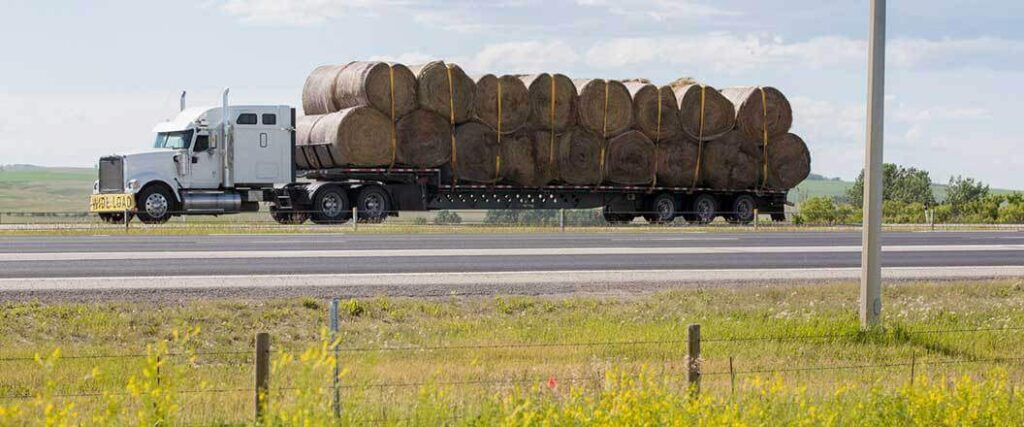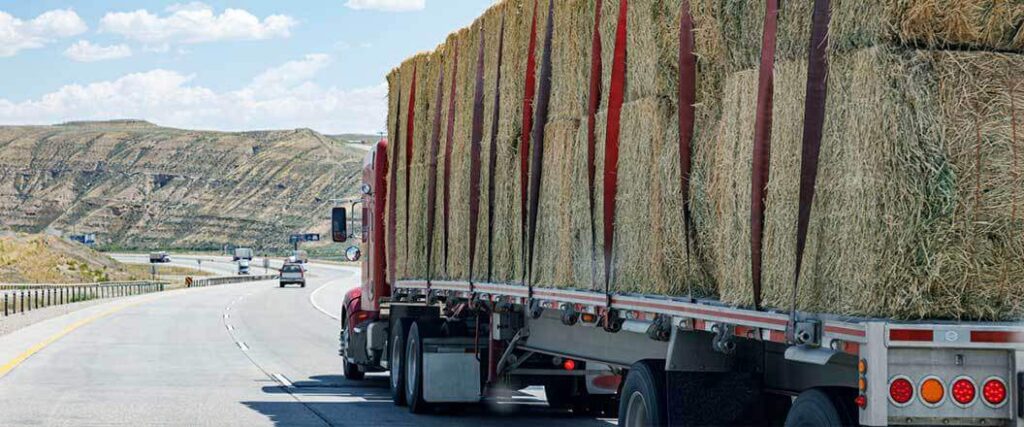Hay transport plays a critical role in feeding livestock and supporting ecosystems. However, hauling hay safely isn’t easy. Several factors affect transporting hay, such as bale shapes and the prevention of damage in transit. Understanding these factors is key to making sure this important cargo reaches its destination.
According to the American Association of Port Authorities (AAPA), hay transport is a crucial component in the agricultural supply chain. Ensuring the safe transport of hay bales requires knowledge and careful attention. Proper handling during transit maintains hay quality, meeting the demands of both suppliers and consumers.
Read along as we review the basics of hay transportation, including types of bales, hay bale flatbed hauling, and best practices for safe transit.

Shipping hay might sound straightforward when compared to heavy machinery or hazardous chemicals. However, challenges can still occur when hauling this humble payload.
These challenges include:
It’s easy to see that this seemingly simple commodity actually requires a great deal of attention to transport properly. The weight and volume of hay can pose unique challenges during transportation, demanding meticulous planning and execution.
To learn what successful hay hauling looks like, let’s start by examining the size and shape of the payload itself.

There are two primary hay bale types, and depending on the type, the approach to hauling can vary. These two basic types are round and square hay bales. Each shape requires some special consideration during the transport process.
Round hay bales have gained popularity because they are well-suited to mechanical handling and are often preferred for feeding large herds. Their design is ideal for longer storage periods and less frequent feedings, making them particularly useful for large-scale farming operations.
The average dimensions of a round hay bale are:
Let's dig into the reasons round hay bales are used.
For all of these advantages, the round shape can present challenges in transit, such as:
Strapping, blocking, and bracing are especially important when hauling round bales. Make sure not to leave any room for the bales to shift, otherwise balance issues are likely to occur.
Square hay bales are a common sight in smaller farms, horse stables, and even backyard gardens. Their compact size and symmetrical shape makes them relatively easy to haul.
Here's a look at their average dimensions and why they often get picked over round bales.
Square bales are easy to handle, especially for smaller operations or individual animal owners. The shape makes them easy to stack, allowing for efficient storage. They're also easier to break apart for feeding smaller groups or individual animals.
For haulers, the benefits of square bales are:
As far as challenges go, square bales are more susceptible to excessive moisture than their round counterparts. For this reason, keeping them dry (but not too dry) in transit is more difficult.
Square hay bales, due to their versatility and manageable size, are a popular choice for both small and large operations. While their shape poses some challenges during the hauling process, proper techniques and equipment can largely mitigate these issues.

The following calculations are based on a standard flatbed trailer with dimensions of 48’L x 8.5’ W with a maximum legal stacking height of 8.5’.
| Shape | Dimensions | Bales per Truckload |
| Small square | 14”x18”x36” | 410 |
| Large square | 3’x3’x8’ | 32 |
| Round | 4’x5’x5’ | 18 |
While it’s not impossible to stack bales higher or wider under some circumstances, special permits for an oversized load will be required.

Time and safety are crucial in shipping your heavy and oversized hay bale payload. Fill out our quick quote form to get the right advice you need in no time!
How are bales transported? Flatbed trailers are often the vehicle of choice for hay transport. Let's dive into why flatbed trailers are so advantageous for this job.
The open design of flatbeds makes securing your load correctly of paramount importance, which leads us into our next topic: how to ensure you're transporting hay bales safely.
Hay may not be as daunting of a payload as oversized concrete tanks or utility poles, but it’s still vital to follow safety procedures when loading, hauling, and unloading your bales. Let’s review some tried-and-true safety measures for each stage of hay transportation.
Before hitting the road, it's crucial to complete a pre-transport checklist. This is a key step in ensuring a smooth and safe hay-hauling experience.
Before you and your hay hit the road, make sure to:.
By following this pre-transport checklist, you can mitigate many risks associated with hay shipping. With that said, how you load and secure your hay bales is just as crucial.

When it comes to loading hay bales onto a trailer, certain techniques can make the job easier while ensuring a safer transport process.
Keep the following in mind during the hay bale loading process.
After you’ve loaded your hay bales, the next step is making sure they're securely fastened for the journey.
Securing hay bales with quality tie-downs and restraints is a must. Inadequate or faulty equipment increases the risk of hay bales shifting during transit, which can create dangerous situations on the road.
Depending on the bale type, size, and the length of the journey, different kinds of straps and tie-downs may be suitable.
In addition to these tie-down methods, there are special considerations required for shipping hay as a less than truckload (LTL) payload. Under these circumstances, the hay will share space with different kinds of cargo.
Hay shipped LTL will usually need to be palletized and heavily wrapped to keep it from damaging any other cargo in the trailer.
Even the best tie-downs can loosen during a trip. Regular inspections during your journey are a must to ensure your payload arrives intact.

Shipping large and heavy items is no easy task, but it’s what we do best. Our heavy haul specialists are ready to handle your biggest jobs with ease! Give us a call at (855) 490-2433 and let us help with your next big shipment.
For semi trucks hauling hay commercially, there are no federal limitations on transporting hay across state lines. On the state level, California does enforce certain rules regarding hay entering the state. It must be free of noxious weeds and insect pests.
If you are hauling hay to California, make sure your payload is free of these contaminants, and be prepared for inspection.
On a domestic level, hay is usually shipped via semi truck and trailer. This is the most affordable, efficient method of transporting hay to its final destination. It’s not uncommon to see pickup trucks hauling hay via a gooseneck trailer, but this is less efficient and not ideal for long-distance transportation.
The truck and trailer combination is also the most common method for transporting hay to and from Canada and Mexico. Due to infestation concerns, Canada requires a phytosanitary certificate for shipments of hay going to most parts of the country.
Hay is also shipped internationally via cargo vessels, and the U.S. routinely exports alfalfa hay to trading partners such as China, Japan, and Taiwan.
Hay has a crucial role in the dairy, meat, and horse industries, and its importance in those sectors can’t be understated. That’s why it’s essential to make sure any hay you purchase or ship is handled by experts in hauling large cargo.
Heavy Haul and Oversized is an industry leader in hauling all things big, tall, and wide. Our services include:
Don’t take chances with your haul of hay. Call our expert team at (866) 902-2713, or get a risk-free quote today. Your cows will thank you.
Heavy Haul and Oversized
315 NE 14th Street #4122
Ocala, FL 34470